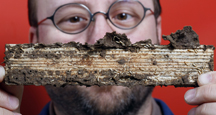Termites' digestive system could act as biofuel refinery

Mike Scharf's work with termites has shown that the insects' digestive systems may help break down woody biomass for biofuel production. (Purdue Agricultural Communication photo/Tom Campbell)
WEST LAFAYETTE, Ind. - One of the peskiest household pests, while disastrous to homes, could prove to be a boon for cars, according to a Purdue University study.
Mike Scharf, the O. Wayne Rollins/Orkin Chair in Molecular Physiology and Urban Entomology, said his laboratory has discovered a cocktail of enzymes from the guts of termites that may be better at getting around the barriers that inhibit fuel production from woody biomass. The Scharf Laboratory found that enzymes in termite guts are instrumental in the insects' ability to break down the wood they eat.
The findings, published in the early online version of the journal PLoS One, are the first to measure the sugar output from enzymes created by the termites themselves and the output from symbionts, small protozoa that live in termite guts and aid in digestion of woody material.
"For the most part, people have overlooked the host termite as a source of enzymes that could be used in the production of biofuels. For a long time it was thought that the symbionts were solely responsible for digestion," Scharf said. "Certainly the symbionts do a lot, but what we've shown is that the host produces enzymes that work in synergy with the enzymes produced by those symbionts. When you combine the functions of the host enzymes with the symbionts, it's like one plus one equals four."
Scharf and his research partners separated the termite guts, testing portions that did and did not contain symbionts on sawdust to measure the sugars created.
Once the enzymes were identified, Scharf and his team worked with Chesapeake Perl, a protein production company in Maryland, to create synthetic versions. The genes responsible for creating the enzymes were inserted into a virus and fed to caterpillars, which then produce large amounts of the enzymes. Tests showed that the synthetic versions of the host termite enzymes also were very effective at releasing sugar from the biomass.
They found that the three synthetic enzymes function on different parts of the biomass.
Two enzymes are responsible for the release of glucose and pentose, two different sugars. The other enzyme breaks down lignin, the rigid compound that makes up plant cell walls.
Lignin is one of the most significant barriers that blocks the access to sugars contained in biomass. Scharf said it's possible that the enzymes derived from termites and their symbionts, as well as synthetic versions, could be more effective at removing that lignin barrier.
Sugars from plant material are essential to creating biofuels. Those sugars are fermented to make products such as ethanol.
"We've found a cocktail of enzymes that create sugars from wood," Scharf said. "We were also able to see for the first time that the host and the symbionts can synergistically produce these sugars."
Next, Scharf said his laboratory and collaborators would work on identifying the symbiont enzymes that could be combined with termite enzymes to release the greatest amount of sugars from woody material. Combining those enzymes would increase the amount of biofuel that should be available from biomass.
The U.S. Department of Energy and Chesapeake Perl funded the research.
Writer: Brian Wallheimer, 765-496-2050, bwallhei@purdue.edu
Source: Mike Scharf, 765-496-6710, mscharf@purdue.edu
Ag Communications: (765) 494-2722;
Keith Robinson, robins89@purdue.edu
Agriculture News Page
ABSTRACT
Multiple Levels of Synergistic Collaboration
in Termite Lignocellulosic Digestion
Michael E. Scharf, Zachary J. Karl, Amit Sethi, Drion G. Boucias
In addition to evolving eusocial lifestyles, two equally fascinating aspects of termite biology are their mutualistic relationships with gut symbionts and their use of lignocellulose as a primary nutrition source. Termites are also considered excellent model systems for studying the production of bioethanol and renewable bioenergy from second-generation (non-food) feedstocks. While the idea that gut symbionts are the sole contributors to termite lignocellulose digestion has remained popular and compelling, in recent years host contributions to the digestion process have become increasingly apparent. However, the degree to which host and symbiont, and host enzymes, collaborate in lignocellulose digestion remain poorly understood. Also, how digestive enzymes specifically collaborate (i.e., in additive or synergistic ways) is largely unknown. In the present study we undertook translational-genomic studies to gain unprecedented insights into digestion by the lower termite Reticulitermes flavipes and its symbiotic gut flora. We used a combination of native gut tissue preparations and recombinant enzymes derived from the host gut transcriptome to identify synergistic collaborations between host and symbiont, and also among enzymes produced exclusively by the host termite. Our findings provide important new evidence of synergistic collaboration among enzymes in the release of fermentable monosaccharides from wood lignocellulose. These monosaccharides (glucose and pentoses) are highly relevant to second-generation bioethanol production. We also show that, although significant digestion capabilities occur in host termite tissues, catalytic tradeoffs exist that apparently favor mutualism with symbiotic lignocellulose-digesting microbes. These findings contribute important new insights towards the development of termite-derived biofuel processing biotechnologies and shed new light on selective forces that likely favored symbiosis and, subsequently, group living in primitive termites and their cockroach ancestors.
